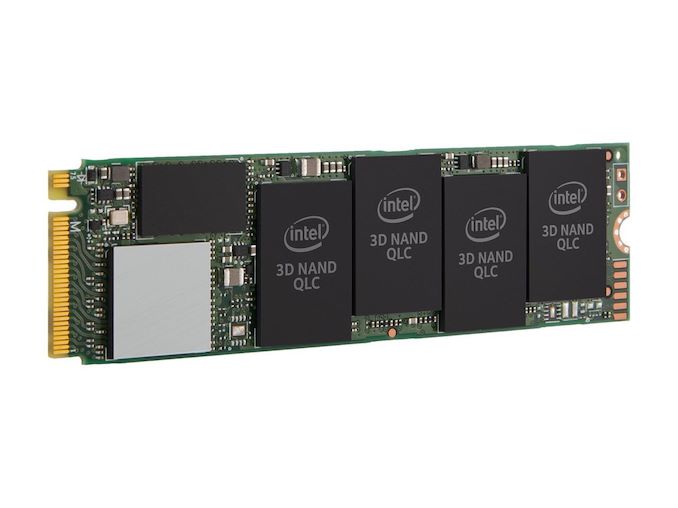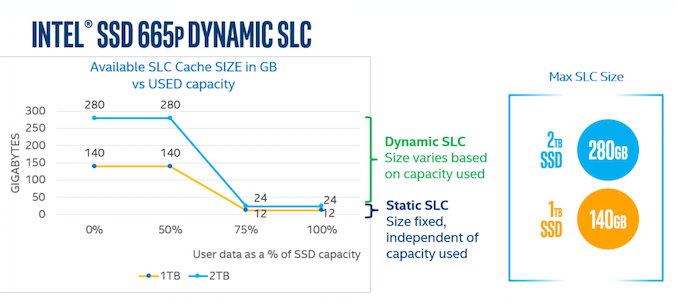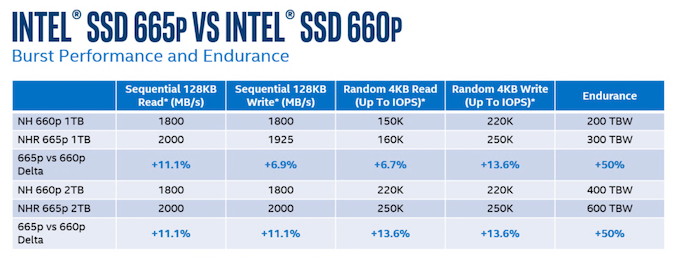Intel Releases SSD 665p: Second-Gen QLC
by Billy Tallis on November 25, 2019 3:00 PM EST
Two months after being announced, the Intel SSD 665p is set to be released today. The 665p is the successor to the 660p, the most (only?) successful consumer SSD based on four bit per cell (QLC) NAND flash memory. The 665p makes minimal changes to the design of the 660p; the most important of which is switching from Intel's 64-layer 3D QLC NAND to their newer 96-layer 3D QLC NAND.
Intel claims to have the first 96L QLC in production, though Western Digital has already announced they are shipping products using their own 96L QLC (albeit not in internal SSDs yet). It appears that production of Intel's 96L has not ramped up much yet, because today we are only getting the 1TB SKU of the 665p—the 2TB model won't be arriving until Q1 of 2020. The 512GB model won't be happening at all. The 512GB 660p was much more susceptible to the performance downsides of QLC NAND than the larger models, and given the pricing of 512GB-class TLC-based drives, it's reasonable for QLC product lines to start with a minimum of 1TB.
The 665p continues to use the Silicon Motion SM2263 NVMe SSD controller, with a small DRAM cache and a massive variable-size SLC cache:
The switch to 96L QLC has enabled minor performance improvements. The basic performance specs have been boosted by up to 13.6%, which isn't enough to noticeably impact real-world use cases. This is still an entry-level NVMe SSD that could get by just fine with a mere PCIe 3.0 x2 connection even though it supports an x4 link. As usual, these specs are for burst performance where the SLC cache is in use; post-SLC write speeds are still slower than what any vendor wants to put on a spec sheet. When Intel announced the 665p in September, they showed CrystalDiskMark results for the 660p vs the 665p that cast the 665p in a much better light, but their numbers for the 660p were suspiciously low.
Much more important than the performance changes is the write endurance boost the 665p brings compared to the 660p. Both capacities of the 665p have 50% higher rated write endurance than the 660p, bringing them up to about 0.16 drive writes per day (DWPD) from the 660p's 0.11 DWPD. This is still a lot lower than the 0.3 DWPD that is typical for low-end consumer SSDs that use TLC NAND, but the increase does show that Intel's feeling more confident in their second generation of QLC.
Looking to the future, Intel's next step after 96 layers will be to 144 layers. That generation of 3D NAND will be QLC-only at first and will arrive in the second half of 2020. So Intel may end up doing a second refresh of this SSD about a year from now before this product segment is ready to move to PCIe 4.0.
Newegg is currently selling the 1TB 660p for $82.99 as part of their Black Friday sales, making it one of the cheapest SSDs on a per-GB basis, in any form factor, interface or capacity. We're not expecting the 665p to debut at such a low price, but after the holiday sales are over the 665p will probably overtake the 660p as the most affordable NVMe SSD.
Intel is not sampling the 1TB 665p for review at this time, but we've asked for a review sample of the 2TB model when it becomes available.
Related Reading:
- Intel Announces SSD 665p: Denser, Faster QLC NAND
- Intel Shares New Optane And 3D NAND Roadmap - Barlow Pass DIMMs & 144L QLC NAND in 2020
- Western Digital Begins Shipments of 96-Layer 3D QLC-Based SSDs, Retail Products
- Biostar Launches M700 SSDs: Entry-Level PCIe SSDs
- Team Group Unveils MP33 SSDs: Entry-Level PCIe Drives
- Best SSDs: Holiday 2019












28 Comments
View All Comments
dlum - Wednesday, November 27, 2019 - link
Meh, all these people grumbling endlessly about a product not fitting their use case, when it's clear & obvious that it is just that, e.g. not fitting their use case.I run a professional shop dealing with large remote sensing dataset analyses & machine learning, got a (small) cluster of machines and invested heavily in 660p SSDs and they're just ABSOLUTELY PERFECT for incredibly fast access to slowly-changing, large-file datasets, that are read many, many times. The expected endurance will last me for 4-8 years, they're dead cheap, and consume next to no power, esp. when idle. So 660p marked for me the first moment to move from HDDs to SSD for large part of my operations. The only pity being they max at 2 TB / some work required to a lot of them in the system.
Perfect product for my use case. I will certainly enjoy the 665p upgrade as well.
Spunjji - Wednesday, November 27, 2019 - link
Complaining about TLC is a bit of a "tell", as its performance these days is way more than high enough for 95% of use cases.Speak for yourself but I definitely benefit from drives larger than 500GB.
PeachNCream - Saturday, November 30, 2019 - link
Performance is not endurance.Dragonstongue - Tuesday, November 26, 2019 - link
ummm is the Samsung QDC not considered consumer class as they been on sale for many many months now, certainly targeted at similar price point of other consumer class SSD drives?maybe nvme I understand that side I suppose, thought Intel is likely not at all first and only consumer wise quad level cell?
myself, for the price point ~$120 Canadian (if close to similar black friday pricing)
for capacity that is pretty nice, however, the endurance of quad level overall vs 3d / TLC etc
leaves much to be desired .. they are not nearly as fast nor have close to same endurance
save the maker apprently big $$$$$$$$ to slap on shelf vs other types of NAND, certainly not see this reflected in the pricing for me and you though ( IMHO ) which is a crying shame
so my sentiment, why bother even putting for consumers if we want speed / endurance / capacity best off to keep to the TLC - 3d - V-nand whatever "they" want to call it
I quite doubt "these days" flash memory is anywhere close to the price they are charging (sole exception being the bleeding edge NVME / pci-e based stuff which is quite pricey likely much "waste" .. though I likely could be very wrong as well .. they charge whatever they want to, regardless if it costs .0000001$ to make it -- this why we cant all have nice things
andrewaggb - Tuesday, November 26, 2019 - link
My samsung magician stats for my main computer show 22.7 TB written over 1.75 years of uptime for a 1 TB 850 EVO boot/system drive. I think that works out to 0.036 DWP. It's half empty and I don't have a steam or epic library on there and whatnot but it seems to me that many users (especially casual ones) should be just fine with a 660/665p.vladx - Tuesday, November 26, 2019 - link
Agreed, My 840 Evo is still running without issues after almost 5 years.Hurn - Tuesday, November 26, 2019 - link
My 840 EVO has had read speed issues - voltage drift in the cell causes rereads. This was heavily commented on, back at the time (specs would show 550 MBps read, but after a couple of months, would be seeing more like 80 MBps read speed - this is when TLC was brand new). Firmware "fixes" didn't help much - only way to get full read speed back (temporarily) is completely reimaging (rewrite every block), so they made a tool which they added to their Samsung Magician app. Trouble with re-writing the drive every few months is that shortens the usable lifespan. Trade off: do you want it fast or want it to last?vladx - Tuesday, November 26, 2019 - link
That's unfortunate, in my case the second fix from Samsung completely solved any speed issues. Even with the write cycles used by the fix, my 840 Evo is still at 90% health so those consumed cycles have no real impact whatsoever.I've seen other people spreading FUD about the 840 Evo, I guess the world will always have gullible people who choose to believe it.